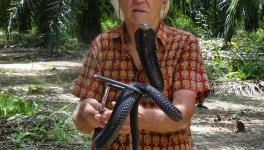WHO Releases Strategy to Deal With Snake Bites

World Health Organisation (WHO), on May 23, 2019, released the long-anticipated World Health Organisation (WHO) strategy on the prevention and management of snakebite envenoming. The strategy noted, “Snakebite envenoming is a neglected tropical disease (NTD) that is responsible for enormous suffering, disability and premature deaths on every continent. As over 5.8 billion people are at risk of encountering a venomous snake, it is not surprising but no less tragic that almost 7,400 people every day are bitten by snakes, and 220–380 men, women and children die as a result (1, 2, 3), adding up to about 2.7 million cases of envenoming and 81,000–1,38,000 deaths a year.”
As NewsClick has reported earlier, although there exist no official data of the number of deaths caused by snakebites in India, various estimates show that approximately around 50,000 people die of snake bites every year. The international medical humanitarian organisation, Médecins Sans Frontières (MSF) observed, “Snakebite envenoming overwhelmingly afflicts the rural poor, including migrant workers, farmers, and displaced people fleeing conflict or violence, and kills more people than any other disease on WHO’s Neglected Tropical Diseases list.”
Also Read: Death By Snakebite: Another Neglected Problem of the Poor
The WHO in 2017 re-recognised snake bite as a neglected tropical disease, after dropping it as one in 2013, due to the efforts of various civil societies. The approach to this non-negligible death causing factor in India is horrifying as it is not listed as one of the ‘neglected diseases’ in the country, thus being ignored by the health policy makers. Speaking to MSF about the WHO strategy, Romulus Whitaker from the Indian Snakebite Initiative noted, “This is an opportunity to finally get serious about tackling snakebites in India and stop unnecessary deaths and disabilities from snakebites.”
The WHO Strategy
The released strategy is for a 12-year period and the budget for its implementation would be provided by WHO itself. The global organisation will be investing in providing technical support to all the countries where snake bite is a public health issue. The plan, however, cannot be implemented without the countries involved, “The countries should mobilise both domestic and international resources to achieve sustainable financing and implementation of their control programmes, with strong technical support from WHO,” the organisation noted.
The main issue with handling snake bite cases in the country and elsewhere as NewsClick had earlier reported is the unavailability of anti-venom. WHO, however, has specified that national costs and the cost of commodities to be deployed for anti-venom stockpiles are not included in it’s budget; but the strategy aims for strengthening the production of anti-venom.
There has always been a problem of low production of anti-venom. WHO in its earlier reports had noted “a significant challenge in manufacturing of anti-venoms is the preparation of the correct immunogens (snake venoms). At present, very few countries have capacity to produce snake venoms of adequate quality for anti-venom manufacture, and many manufacturers rely on common commercial sources.” This along with the lack of proper data on types of snake bites and number of snake bites has led to the anti-venom crisis. It further notes, “Poor regulation and the marketing of inappropriate or poor quality anti-venoms has also resulted in a loss of confidence in some of the available anti-venoms by clinicians, health managers, and patients, which has further eroded demand.”
Also Read: How Medical Myths are Propagated
Because of this erosion of demand, several manufacturers have ceased production, and the price of some antivenom products have dramatically increased in the last 20 years, making treatment unaffordable for the majority of those who need it. This drastic increase in price of anti-venoms in turn suppresses the demand. “The entry into some markets of inappropriate, untested, or even fake anti-venom products has also undermined confidence in anti-venom therapy generally,” states the WHO report. MSF notes, the supply of anti-venom treatments continues to be a problem in the most affected countries including in India. In some cases, products that have been found ineffective are still being marketed and there is an urgent need for the production of safer, stronger and more effective anti-venoms free from the dangers of an allergic reaction.
The current strategy of WHO is to strengthen the production of anti-venom. Apart from looking into the production of anti-venom, the current strategy focuses on,
- Empowering and engaging communities.
- Ensuring safe and effective treatment.
- Strengthening health systems.
- Increasing partnerships, coordination and resources.
MSF India and the Indian Snakebite Initiative have welcomed this strategy and has urged the Government of India to step up and support this strategy with the urgency and attention it demands.
Get the latest reports & analysis with people's perspective on Protests, movements & deep analytical videos, discussions of the current affairs in your Telegram app. Subscribe to NewsClick's Telegram channel & get Real-Time updates on stories, as they get published on our website.















